Banded Bay Cuckoo Cacomantis sonneratii in China is resident in southern and western Yunnan. HABITAT & BEHAVIOR Broadleaved forests, to 1300 m (4,270 ft.). Heard more often than seen. Often sallies for flying insects. Parasitizes nests of bulbuls, minivets, small babblers, and Common Iora. ID White supercilium above dark eyeline. White underparts finely barred black. Rich brown above, including crown, with wing a bit darker; all barred blackish. Tail tipped white. Juvenile is even more barred above and has less obvious supercilium. BARE PARTS Bill black above, greenish-grey below; eye dark. Feet grey. VOICE Loud, four-syllable call, somewhat like Indian Cuckoo but more quickly uttered and thinner. Other call of several notes, rising in pitch and speed then breaking off suddenly. — Craig Brelsford
SOUND-RECORDINGS
Banded Bay Cuckoo Cacomantis sonneratii, four-note whistle, Baoshan (25.401533, 99.287200), Yunnan, China, elev. 1290 m (4,230 ft.), March, by Craig Brelsford (0:07, 1.1 MB)
Banded Bay Cuckoo Cacomantis sonneratii, rising call plus four-note whistle, Baoshan (25.401533, 99.287200), Yunnan, elev. 1290 m (4,230 ft.), March, by Craig Brelsford (1:18, 3.9 MB)
RESOURCES ON CUCKOOS
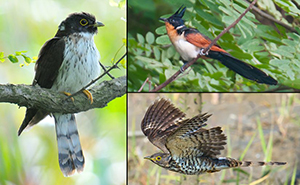
The Cuckoos of Shanghai: Craig Brelsford examines the Shanghai-area parasitic cuckoos and teaches you how to tell them apart. The non-Cuculus parasitic cuckoo that one is most likely to see in Shanghai is Large Hawk-Cuckoo. Rufous Hawk-Cuckoo, Asian Koel, and Chestnut-winged Cuckoo also are occasionally noted.
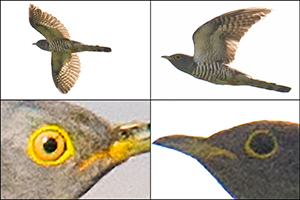
Indian Cuckoo & Common Cuckoo: A Comparison: Note the smaller size of Indian Cuckoo, its thicker barring, and its darker iris. Voice as always is the surest differentiator. Both Indian Cuckoo and Common Cuckoo occur on passage in Shanghai and breed in the region.
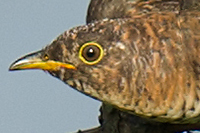
Why This Cuckoo Is Lesser Cuckoo: The Cuculus I saw at Shanghai’s Cape Nanhui in September had the dark eye, well-defined and widely spaced barring, and small size suggestive of Lesser Cuckoo. See my photos of the thrush-sized cuckoo.
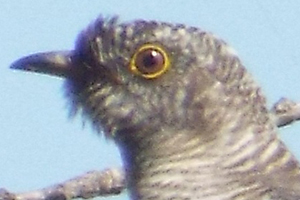
My Exchange with a Reader About Cuculus Cuckoos: “Draw a circle around the five [Cuculus] cuckoos [of China],” Craig Brelsford instructs a shanghaibirding.com reader. “Within that circle, draw three circles: one around Indian, one around Lesser, and one around Common, Himalayan, and Oriental.” Using this method, one quickly clusters the three main groups of Cuculus in China.
THE CUCKOOS OF CHINA
shanghaibirding.com covers every species in the order Cuculiformes in China. Click any link:
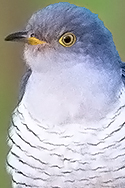
Greater Coucal Centropus sinensis
Lesser Coucal C. bengalensis
Green-billed Malkoha Phaenicophaeus tristis
Chestnut-winged Cuckoo Clamator coromandus
Jacobin Cuckoo C. jacobinus
Asian Koel Eudynamys scolopaceus
Asian Emerald Cuckoo Chrysococcyx maculatus
Violet Cuckoo C. xanthorhynchus
Banded Bay Cuckoo Cacomantis sonneratii
Plaintive Cuckoo C. merulinus
Square-tailed Drongo-Cuckoo Surniculus lugubris
Large Hawk-Cuckoo Hierococcyx sparverioides
Common Hawk-Cuckoo H. varius
Northern Hawk-Cuckoo H. hyperythrus
Hodgson’s Hawk-Cuckoo H. nisicolor
Lesser Cuckoo Cuculus poliocephalus
Indian Cuckoo C. micropterus
Himalayan Cuckoo C. saturatus
Oriental Cuckoo C. optatus
Common Cuckoo C. canorus
ACKNOWLEDGEMENTS
Daniel Bengtsson served as chief ornithological consultant for Craig Brelsford’s Photographic Field Guide to the Birds of China, from which this species description is drawn.
